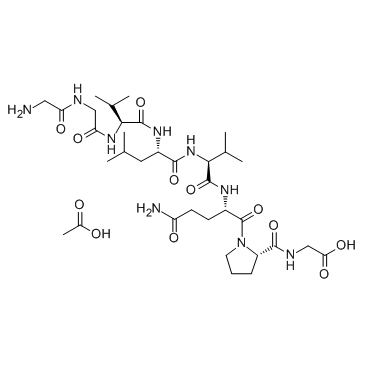Larazotide acetate
Modify Date: 2025-08-26 22:05:22

Larazotide acetate structure
|
Common Name | Larazotide acetate | ||
|---|---|---|---|---|
| CAS Number | 881851-50-9 | Molecular Weight | 785.88500 | |
| Density | N/A | Boiling Point | N/A | |
| Molecular Formula | C34H59N9O12 | Melting Point | N/A | |
| MSDS | N/A | Flash Point | N/A | |
Use of Larazotide acetateLarazotide acetate is a synthetic peptide that functions as a tight junction regulator and reverses leaky junctions to their normally closed state. |
| Name | acetic acid,2-[[(2S)-1-[(2S)-5-amino-2-[[(2S)-2-[[(2S)-2-[[(2S)-2-[[2-[(2-aminoacetyl)amino]acetyl]amino]-3-methylbutanoyl]amino]-4-methylpentanoyl]amino]-3-methylbutanoyl]amino]-5-oxopentanoyl]pyrrolidine-2-carbonyl]amino]acetic acid |
|---|---|
| Synonym | More Synonyms |
| Description | Larazotide acetate is a synthetic peptide that functions as a tight junction regulator and reverses leaky junctions to their normally closed state. |
|---|---|
| Related Catalog | |
| Target |
Paracellular permeability[1] |
| In Vitro | Larazotide acetate inhibits the redistribution and rearrangement of zonula occludens-1 (ZO-1) and actin caused by AT-1002 and gliadin fragments in Caco-2 and IEC6 cells. Larazotide acetate inhibits the AT-1002-induced TEER reduction and TJ opening in Caco-2 cells. Larazotide acetate inhibits the translocation of a gliadin 13-mer peptide, which has been implicated in celiac disease, across Caco-2 cell monolayers. Further, apically applied Larazotide acetate inhibits the increase in TJ permeability elicited by basolaterally applied cytokines[1]. |
| In Vivo | When tested in vivo in gliadin-sensitized HLA-HCD4/DQ8 double transgenic mice, larazotide acetate inhibits gliadin-induced macrophage accumulation in the intestine and preserved normal tight junction structure[1]. |
| Cell Assay | Caco-2 cells are seeded onto 12-well plate and grown for 21–28 days until fully differentiated. The apical and basolateral compartments of Caco-2 cell monolayers are pre-incubated in Hank’s Balanced Salt Solution (HBSS) at 37°C for 30 min. Treatment solutions containing 7.5 mM LY with or without AT-1002 (7 mM) and different concentrations of larazotide acetate (5, 10, 12.5, 15 mM) in HBSS are added to the apical compartment of each monolayer and incubated at 37°C, 50 rpm for 180 min. At the end of the incubation, samples are removed from the basolateral compartment and analyzed in a fluorescence plate reader at excitation and emission wavelengths of 485 nm and 535 nm, respectively. The increase in LY passage is calculated for each treatment and is expressed relative to that of untreated controls[1]. |
| Animal Admin | Mice[1] Cohorts of HLA-HCD4/DQ8 mice (n=10 each) are sensitized (i.p.) with 500 μg of gliadin dissolved in 0.02 mM acetic acid in 50 μg of Complete Freund’sAdjuvant; thereafter, mice are gavaged with gliadin (2 mg/mouse), +/− treatment, 2×/week for 7 weeks. Group 1 receives larazotide acetate (250 μg/mouse) and gliadin, Group 2 receives AT-1002 (250 μg/mouse) and gliadin, and Group 3 is gavaged with gliadin only. A group of non-sensitized controls (CFA, i.p. only) is gavaged with rice. Twenty-four hours after the last gavage, small intestinal tissue is mounted in Ussing chambers for the measurement of electrical parameters (Isc, conductance) and macromolecule transport (horseradish peroxidase [HRP] flux). Tissue is processed for macrophage counts by immunohistochemistry using F4/80 antibody specific for a macrophage-restricted cell surface glycoprotein[1]. |
| References |
| Molecular Formula | C34H59N9O12 |
|---|---|
| Molecular Weight | 785.88500 |
| Exact Mass | 785.42800 |
| PSA | 360.55000 |
| LogP | 3.73650 |
| Storage condition | 2-8℃ |
| Larazotide acetate |
| UNII-FO8S2IW40N |